Related Research Articles

Plumbing is any system that conveys fluids for a wide range of applications. Plumbing uses pipes, valves, plumbing fixtures, tanks, and other apparatuses to convey fluids. Heating and cooling (HVAC), waste removal, and potable water delivery are among the most common uses for plumbing, but it is not limited to these applications. The word derives from the Latin for lead, plumbum, as the first effective pipes used in the Roman era were lead pipes.

A wrench or spanner is a tool used to provide grip and mechanical advantage in applying torque to turn objects—usually rotary fasteners, such as nuts and bolts—or keep them from turning.
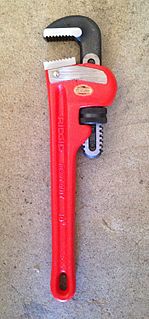
A pipe wrench is any of several types of wrench that are designed to turn threaded pipe and pipe fittings for assembly (tightening) or disassembly (loosening). The Stillson wrench, or Stillson-pattern wrench, is the usual form of pipe wrench, especially in North America. The Stillson name is that of the original patent holder, who licensed the design to a number of manufacturers. The patent expired decades ago. Another type of wrench often used on pipes, the plumber wrench, is also called a pipe wrench in some places.

A socket wrench is a type of spanner that uses a closed socket format, rather than a typical open wrench/spanner to turn a fastener, typically in the form of a nut or bolt.

A hose clamp is a device used to attach and seal a hose onto a fitting such as a barb or nipple.
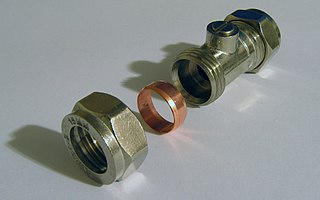
A compression fitting is a fitting used in plumbing and electrical conduit systems to join two tubes or thin-walled pipes together. In instances where two pipes made of dissimilar materials are to be joined, the fittings will be made of one or more compatible materials appropriate for the connection. Compression fittings for attaching tubing (piping) commonly have ferrules in them, and are sometimes referred to as flareless fittings. There are also flare fittings that do not require ferrules/olives.
Nipple Wrench can refer to:

In plumbing and piping, a nipple is a fitting, consisting of a short piece of pipe, usually provided with a male pipe thread at each end, for connecting two other fittings.
A nipple is part of the breast, in anatomy.

A spoke nipple holds a bicycle wheel's rim to each spoke.
Flare fittings are a type of compression fitting used with metal tubing, usually soft steel, ductile (soft) copper and aluminum, though other materials are also used. In a flare fitting the tube itself is "flared" i.e. expanded and deformed at the end. The flare is then pressed against the fitting it connects to and is secured by a close-fitting nut that ensures that no leakage happens. Tube flaring is a type of forging operation, and is usually a cold working procedure. During assembly, a flare nut is used to secure the flared tubing's tapered end to the also tapered fitting, producing a pressure-resistant, leak-tight seal. Flared connections offer a high degree of long-term reliability and for this reason are often used in mission-critical and inaccessible locations.
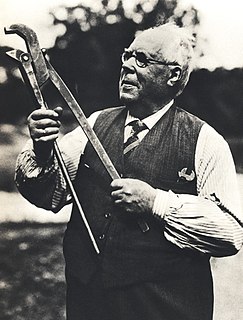
A plumber wrench is a form of plier described as a pipe wrench that uses compound leverage to grip and rotate plumbing pipes. Similar to the action of a Vise Grip plier, its jaw opening is adjusted to width by rotating a threaded ring. Its advantage is that it grips with significant force without needing to engage a lock nut like an adjustable tongue-and-groove plier. Like these, it can also be used on nuts, particularly hex shaped, and other flat engagement points. If used carelessly it can dent or break plumbing pipe.
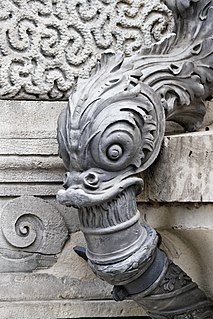
A pipe is a tubular section or hollow cylinder, usually but not necessarily of circular cross-section, used mainly to convey substances which can flow — liquids and gases (fluids), slurries, powders and masses of small solids. It can also be used for structural applications; hollow pipe is far stiffer per unit weight than solid members.
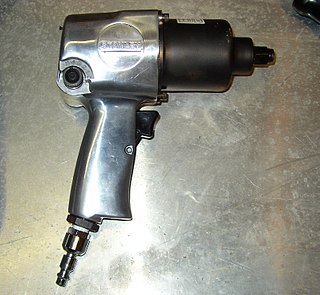
An impact wrench is a socket wrench power tool designed to deliver high torque output with minimal exertion by the user, by storing energy in a rotating mass, then delivering it suddenly to the output shaft. It was invented by Robert H. Pott of Evansville, Indiana.

A threaded pipe is a pipe with screw-threaded ends for assembly.
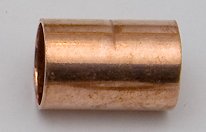
In piping and plumbing, a coupling is a very short length of pipe or tube, with a socket at one or both ends that allows two pipes or tubes to be joined, welded (steel), brazed or soldered together.

A fitting or adapter is used in pipe systems to connect straight sections of pipe or tube, adapt to different sizes or shapes, and for other purposes such as regulating fluid flow. These fittings are used in plumbing to manipulate the conveyance of water, gas, or liquid waste in domestic or commercial environments, within a system of pipes or tubes.
The Ridge Tool Company is an American manufacturing company that makes and distributes tools under the Ridgid brand name. The company was founded in 1923 in North Ridgeville, Ohio. In 1943, it relocated to its current location in Elyria, Ohio, and in 1966, it became a wholly owned subsidiary of Emerson Electric.

A nut is a type of fastener with a threaded hole. Nuts are almost always used in conjunction with a mating bolt to fasten multiple parts together. The two partners are kept together by a combination of their threads' friction, a slight stretching of the bolt, and compression of the parts to be held together.

A basin wrench, sometimes called a sink wrench, is a plumbing tool which is used in confined spaces to turn fasteners that would be difficult or impossible to reach with a plumber wrench or other types of wrenches. For example, the threaded nuts used to secure faucets to sinks are often located in deeply recessed places that can only be accessed with a basin wrench.
References
- ↑ Barclay, Leney (1980-07-22). Residential Plumbing.